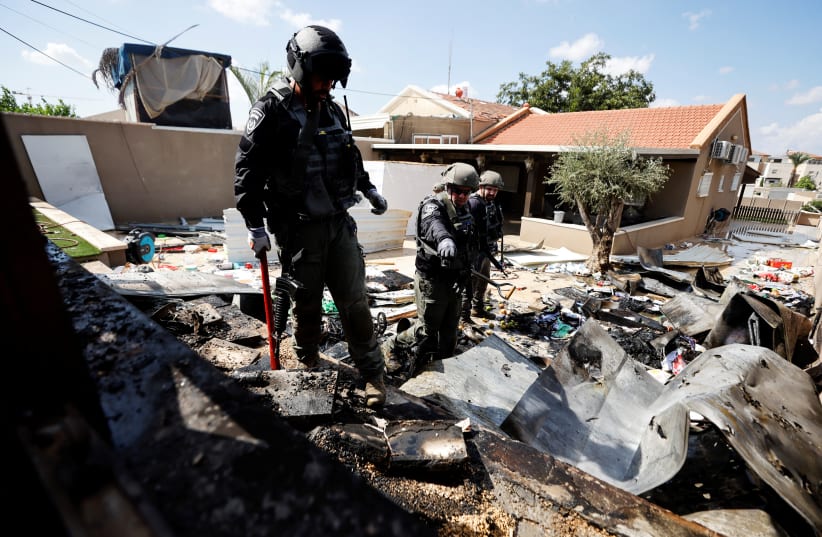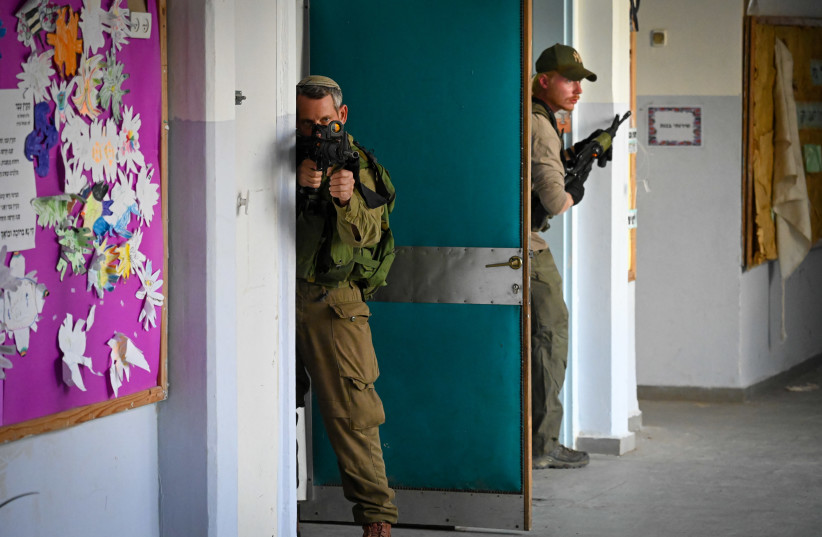The IDF announced on Thursday that schools can reopen in southern Israel close to the Gaza border due to the improved security situation achieved by the IDF's operational control in some parts of Gaza, along with a major reduction in rocket fire.
The change is expected to transform the return of civilians who fled when the war started in October.On January 1, the IDF announced that residents of six towns four to seven kilometers from the border would start returning, for the first time since October. The first towns the IDF cleared to go back were three in the Ashkelon area and three in Shaar Hanegev.Since then, thousands returned to their homes, but currently have had no schooling, which is why many others held off going back.Despite the change, each town is being treated individually, and there are some in Shaar Hanegev and Eshkol still not yet permitted to open schooling.
Part of the issue relates to how many people are allowed to gather together in closed spaces.With the IDF dropping the danger level from 3 to 2, 100 people are now allowed to congregate indoors together and up to 300 outdoors, whereas before the limits were 50 indoors and 100 outdoors, which made schooling difficult or impossible.Generally, the IDF has been first allowing residents to return to areas closer to northern Gaza, where it has had stronger control for longer, whereas towns closer to southern Gaza will need to wait longer, based on gains the IDF expects to make.Towns that are four kilometers from the border are expected to need to wait longer to return. These towns number higher than those further away, and because Hamas managed to significantly destroy houses and infrastructure, it will take longer to rebuild before a return is possible.
Regarding a much larger number of towns which were zero to four kilometers from Gaza, Hamas managed to destroy a more significant amount of houses and infrastructure, which will take longer to rebuild before residents can return.
By press time, there had been no rockets fired from Gaza, nor had there been any on Wednesday, with one fired on Tuesday towards Nahal Oz. Throughout the whole month of January, Hamas only fired three significant double-digit barrages, and even those came nowhere close to the hundreds it could fire per day in the war’s early stages.
No expectation for Israeli northern schools to reopen before summer break
At the same time, the IDF said that there is no expectation of an opportunity to reopen schools for northern border residents.
There has also not been any process of starting to return Northern residents, given that the IDF has not yet succeeded in reducing Hezbollah’s rocket or missile capabilities.Even on Thursday, Hezbollah fired rounds of rockets and missiles at Metulla and Kiryat Shmona. The IDF attacked a Hezbollah location at Tir Harfa with air strikes and counter-attacked the sources of the Hezbollah fire with artillery – but such actions have not stopped the terror group from continuing.Further, there are still expectations that Israel may decide to go into a general war with Hezbollah to reduce the long-term threat it presents, in which case it would be counterproductive to have residents return to a place where they would be more vulnerable.With all these considerations, the difference between continuing to return to more routine life in the South against no positive movement in the North is expected to lead to heightened criticism of both the government and the IDF.Amid this criticism, the Defense Ministry on Thursday announced that 427 houses of northern residents have had structural damage by Hezbollah rockets and missiles since October, 80 of which experienced direct hits and significant damage.Around 80,000 residents evacuated their homes in October under Hezbollah fire, once the war between Israel and Hamas started.Defense Ministry Director-General Maj. Gen. (Res.) Eyal Zamir visited northern towns and farms along the Lebanese border on Wednesday, to examine firsthand the state of damage. The announcement was timed to his visit.Yediot Aharonot published similar but different statistics on Thursday, stating that based on figures it obtained from Israel’s Tax Authority, there were over 500 damaged homes.A ministry spokeswoman said the Tax Authority takes into account property damage beyond structural damage, whereas the 427 number is only structural housing damage.The Yediot report also said that the three communities hit hardest were Metulla, with 131 damaged houses, Shlomi with 130, and Manara with 121.Another six communities have significant damage, including Kiryat Shmona, with a larger number of communities having more minor damage.A statement by the ministry said that its “Northern Horizon” Directorate is actively assessing the damage in numerous communities along the border, and coordinating initial rehabilitation efforts in towns where security conditions permit.Guided by Defense Minister Yoav Gallant, the Directorate serves as a liaison between the IDF, the Ministry of Defense, and the regional councils in northern Israel.Recognizing the challenges ahead, Zamir said he is committed to ensuring the security and safe return of residents to their homes.Despite those assurances, Hezbollah has shown no sign that it is willing to withdraw all of its forces from the border with Israel to a point north of Lebanon’s Litani River – what Jerusalem has said would need to happen to allow the northern residents to return.The Jerusalem Post recently learned that a few different ideas are quietly being entertained by the defense establishment to get northern residents to return, even if only around 75% of Hezbollah forces withdraw, provided that all of the terror group’s attacks have ceased and the IDF commits to permanently maintaining two divisions to defend the northern border – a 100% increase in defensive troops.No politicians are discussing this publicly as, at present, they would likely be verbally attacked by the northern residents and others for expressing such views, that do not deal with the Hezbollah threat in a complete manner.Gallant announced on Thursday night that Hamas forces in Khan Yunis have been officially defeated, adding that after additional gains in the governorate, 10,000 Hamas fighters were killed and 10,000 wounded, up from around 9,000 killed and around 8,000 wounded around a week-and-half ago.If true, along with the close-to-2,500 Hamas terrorists arrested, the percentage of Hamas forces out of commission would now be up to between 56-75%, up from 48-64% it was 10 days ago, presuming Hamas’ forces pre-war were between 30,000-40,000.Gallant’s statement would also seem to be a week or a couple of weeks ahead of what the military is saying. IDF sources on Thursday said that Hamas’s forces in Khan Yunis were not yet fully defeated, but rather that all of its battalions were now heavily battered.Earlier this week, the IDF said it was on the verge of taking apart Hamas’s final Khan Yunis battalion in the western section, but appeared to suggest that it could still be some weeks before the process was complete.It was unclear if some additional dramatic progress had been made in the last few days or if Gallant was projecting a bit forward by a week or so.The IDF itself still has not announced full operational control in Khan Yunis, as it did in northern Gaza last month.The defense minister also vowed to rout Hamas in Rafah, where to date, the military has avoided using ground troops so as not to alienate Egypt. However, an increasing number of top officials suggested to the Post that Hamas’s top leaders and many hostages may have moved from Khan Yunis to Rafah.Even once Hamas’s main forces are defeated, the IDF has said that it would face a low-intensity period of clearing out leftover insurgents in smaller skirmishes.The 98th and Paratroopers Brigade continued combat operations in western Khan Yunis, killing a few terrorists in close-encounter combat. The Paratroopers also directed Israeli Air Force jets to target Hamas terrorists and infrastructure.The 162nd Brigade engaged in combat in the north and center of the Strip and conducted operations in the center of Gaza City. In the past 24 hours, dozens of terrorists were killed, despite northern Gaza having been declared in IDF operational control over a month ago.Reportedly, Hamas still has smaller groups of up to 2,000 terrorists who are engaging in lower-grade ambush operations in northern and central Gaza.
Jerusalem Post Staff contributed to this report.

